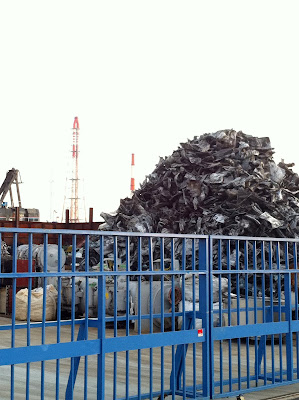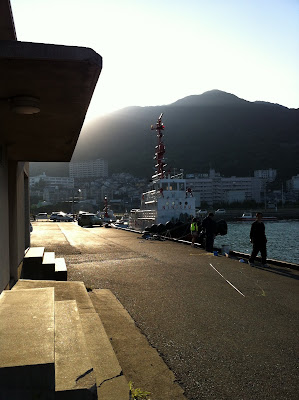All of us love a good hierarchy, but none less than Japan. Venerable Futurebrand and its Country Brand Index (CBI), an organisation which pits the world's nations (well mostly the first world ones it turns out) against each other and ranks them on several criteria. To be expected, the media in each of the named countries 'retweets' this and one Friday in late November a few comments are swapped over the respective beverage, a handful of folks go home glowing, and it's all over until the next year, or the next ranking.
But Japan ? The number one country for tourism ? “Japan has always been a strong country brand and enjoys enormous popularity as a destination for business and leisure" it is said.
The CBI is a comprehensive study of approximately 3,000 international business and leisure travelers from nine countries-the US, the UK, China, Australia, Japan, Brazil, the UAE, Germany and Russia. This is the sample chosen, and Futurebrand is not exactly forthcoming with the distribution or the methodology behind it. Neither does it bother to distinguish business from leisure. If your clients or suppliers are in Japan, do you really have a choice as to where to go for business ?
Care should be taken also in the use of the word ‘destination’, as – and this is a function of airline activity – it sees not insignificant traffic when chosen as a ‘stopover’ en route to Europe.
Strange things happen when you throw the 'brand' word around at random. We suspect Futurebrand might be overusing it. It holds that the most important factors that truly differentiate a nation brand are its associations and attributes – the qualities that people think of when they hear a place name, or look at a photograph or plan a trip.
Natora interprets brand as a 'picture in mind that helps consumers chose your product over another'. One talks of 'well branded' and 'strong brands' and that is what this article is about.
Nations are all playing the tourism card and even post-industrial giants like Japan are investing heavily. Hundreds of countries are throwing resources at selling themselves in any market in which they see potential. This produces clutter, ups competition and calls for smart branding alongside smart marketing.
Lamentably, the CBI information appears to be being taken very seriously by tourism promotion bodies in some countries who work with this to focus on strengths, as if they are unable to soul-search themselves.
Of the many criteria for selection, the concept of authenticity is noteworthy - experiences which are unique and cannot be replicated. Early tourism stressed this. Well healed tourists would travel to locations, however remote to see superlatives; the highest, the lowest, the biggest, the smallest.
Japan is unique yes, but so is Korea and so is China. The modern world sees instant replication of anything which works commercially meaning authenticity is harder and harder to find.
How do the experts do it ?
The US is no expert. To date and thanks to the movie theatre, television and other powerful media, we've all known about the US, and the pull is strangely strong. They simply haven't had to think too much about pulling even more folks to their shores. But they are now. The Corporation for Travel Promotion (CTP) has started on solid ground and is building 'Brand USA'. Adopting the slogan “fresh, unexpected, welcoming and inclusive,” and featuring colourful dots joining to compose the letters USA, the logo was designed to remind the world that “the United States of Awesome Possibilities welcomes everyone”
The US has a branding job on its hand. No one thing can explain who they are as a nation.
Use of personal pronouns you and me is fashionable, and acknowledges that no two travelling styles are alike. Asian tourism giants have been using a single adjective such as 'incredible', 'amazing' and we see the sophisticated marketers moving into personalisation using You and Me. FijiMe is a case in hand which has been extrapolated to ‘RomanceMe’ and others.
From its 'Uniquely Singapore' beginnings, this island state is now particularly impressive. It's 'YourSingapore' destination branding has outranked others. The Singapore Tourist Board (STB) is careful to bring in diverse stakeholders into executing ideas. Singaporean images are already strong, and in successfully reinventing the city thereby securing more material for the brand, the STB is now encouraging visitors to 'scratch below the surface' to 'rediscover'.
New Zealand is regarded as a maverick. It's '100% PureYou' message regularly receives accolades and is meticulously 'stewarded'. Until recently, this read '100% Pure New Zealand' as they highlight the many individual experiences available. Beautiful scenery and the environment is now taking becoming the backdrop as New Zealand focuses on what it feels as its actual leads.
Australia is going beyond branding for tourism purposes to a national brand per se. Simon Anholt of the Anholt City Brand ranking has stressed, “I have never seen an example of a country in all the years I’ve been working in this field that has succeeded in altering its image through marketing communication”
Branding can and does take place at regional, prefectural, metropolitan levels as well as at groupings with essentials in common. The city of Sydney is growing its brand, and involves stakeholders in business, culture, tourism, events and education as it embodies the stature, spirit and strengths of the city. The Anholt City Brand ranking has awarded Sydney the number one spot for a number of years.
Australia's Port Stephens has an interesting take on branding as it makes use of the initial letters in 'PS I Love You'. Simplistic yes, but the research has revealed that the locals have an affinity with the town which might endear them further if presented as a 'post script'.
Elvis Presley was a brand. These days, a country aspiring to grow its tourism activity needs to be Elvis: stand out and stand for something distinctive; do iconic work, one big thing at a time; making sure that it is part of the future.
Brand is organic and it can no longer be constructed unilaterally from on high without the input of actual travellers. Social media conversations these days are market research and are used to fine tune the brand as in “Is the message you’re communicating the message your guests are receiving?”
A brand its logo and tagline should have the clarity of a bell as it conveys the soul, or DNA of a country. A brand is one of the most valuable assets a country has. Brand equity is that portion contributed by a country to supplement existing consumer knowledge. Where knowledge is scant, the opportunity is great to build this equity, and with it, value.
In searching for what Japan is, a useful angle is to isolate what it isn't. Few Asian countries have managed to contain 'chaos'. Japan has. Developing Asian nations thrive on noise and sheer numbers. Japan has these, but is able to contain them. Its people share a quiet dignity and certainly don’t share brashness, but is this marketable ?
Island nations such as Fiji and Tonga play the friendliness card and it generally works. 'Polite and kind' are adjectives often applied to the Japanese, but is this marketable ? Yes it is 'civilised', a label we hear less and less as a descriptor for a society.
Natora sees the brand dialogue as vital. We pursue the following sequence in order to construct brand:
1. Identify Japan’s core competencies – the successful habits ingrained into Japanese society and culture.
2. Identify the key focal areas being developed to strengthen the Japanese brand.
3. Understand awareness of these competencies and areas of focus by the target audience (visitors).
4. Understand what additional expectations are desired from these people.
5. Which of these can be credibly owned and become a reason for visitors to habitually choose Japan?
6. Which key habits does Japan need to develop so that the brand promise can be delivered on at every touchpoint (and which habits need to be erased)?
7. What are the key touchpoints that need to be created / improved to provide a consistent, positive experience?
8. Is a change to Japan’s visual identity necessary?
Natora is starting to see Japan addressing the branding task. Currently it has ‘Japan – Endless Discovery’ and uses the predictable red globe, with cherry blossoms even though these latter are not immediately recognisable as a Japanese icon. Japan persists in using ‘Visit’ in its campaigns where others have left this behind.
Regionally, Shizuoka is commendable and has at last branded itself ‘The Fuji State’ although the message as yet to get out. Few other examples exist.
Nationally, Fotopedia from its US origins has partnered with Hakuhodo for the Narita Airport Authority and is exploiting new platforms such as iphone and iPad, considering these ‘the modern watering holes of the traveller. Japan has stopped short of labelling itself on this occasion, and we suspect it will be the users and how they interact with the content who will give birth to something of value, Brand Japan.



























































